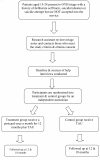Study protocol: the development of a randomised controlled trial testing a postcard intervention designed to reduce suicide risk among young help-seekers
- PMID: 19775469
- PMCID: PMC2759913
- DOI: 10.1186/1471-244X-9-59
Study protocol: the development of a randomised controlled trial testing a postcard intervention designed to reduce suicide risk among young help-seekers
Abstract
Background: Suicidal behaviour and deliberate self harm are common among adolescents. Limited evidence exists regarding interventions that can reduce risk; however research indicates that maintaining contact either via letter or postcard with at-risk adults following discharge from services can reduce risk. The aim of the study is to test a postcard intervention among people aged 15-24 who presented to mental health services but are not accepted, yet are at risk of suicide.
Methods/design: The study is a 3-year randomised controlled trial conducted at Orygen Youth Health Research Centre in Melbourne Australia. Participants are young help-seekers aged 15-24 who are at risk of suicide. Participants will be recruited over a 12 month period. The intervention comprises a regular postcard to be sent monthly for 12 months. The postcard enquires after their well being and includes information regarding individual sources of help and evidence-based self help strategies. Participants are assessed at baseline, 12 and 18 months.
Discussion: This paper describes the development of a study which aims to reduce suicide risk in a sample of young help-seekers. If effective, this intervention could have significant clinical and research implications for a population who can be hard to treat and difficult to research.
Trial registration: The study was registered with the Australian Clinical Trials Registry; number: ACTRN012606000274572.
Figures
References
Publication types
MeSH terms
LinkOut - more resources
Full Text Sources



